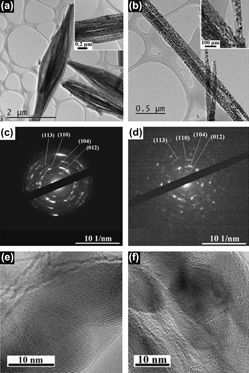Crossref Citations
This article has been cited by the following publications. This list is generated based on data provided by
Crossref.
Ang, Wei An
Cheah, Yan Ling
Wong, Chui Ling
Prasanth, Raghavan
Hng, Huey Hoon
and
Madhavi, Srinivasan
2013.
Mesoporous Cobalt Oxalate Nanostructures as High-Performance Anode Materials for Lithium-Ion Batteries: Ex Situ Electrochemical Mechanistic Study.
The Journal of Physical Chemistry C,
Vol. 117,
Issue. 32,
p.
16316.
Jiang, Zaixing
Li, Jun
Aslan, Hüsnü
Li, Qiang
Li, Yue
Chen, Menglin
Huang, Yudong
Froning, Jens Peter
Otyepka, Michal
Zbořil, Radek
Besenbacher, Flemming
and
Dong, Mingdong
2014.
A high efficiency H2S gas sensor material: paper like Fe2O3/graphene nanosheets and structural alignment dependency of device efficiency.
J. Mater. Chem. A,
Vol. 2,
Issue. 19,
p.
6714.
Cardillo, Dean
Tehei, Moeava
Lerch, Michael
Corde, Stéphanie
Rosenfeld, Anatoly
and
Konstantinov, Konstantin
2014.
Highly porous hematite nanorods prepared via direct spray precipitation method.
Materials Letters,
Vol. 117,
Issue. ,
p.
279.
Cho, Jae Min
Lee, Sae Rom
Sun, Jian
Tsubaki, Noritatsu
Jang, Eun Joo
and
Bae, Jong Wook
2017.
Highly Ordered Mesoporous Fe2O3–ZrO2 Bimetal Oxides for an Enhanced CO Hydrogenation Activity to Hydrocarbons with Their Structural Stability.
ACS Catalysis,
Vol. 7,
Issue. 9,
p.
5955.
Dong, Jidong
Jia, Chuyuan
Song, Yuanjun
He, Jinmei
and
Huang, Yudong
2018.
Improved interfacial properties of carbon fiber-reinforced epoxy composites with Fe2O3/graphene nanosheets using a magnetic field.
Journal of Adhesion Science and Technology,
Vol. 32,
Issue. 9,
p.
1018.
Tang, Feilong
Zhao, Zhongqian
Ren, Kun
Wu, Jian
Chen, Xiumin
Xu, Peilin
Sun, Hongfei
Liu, Qi
Yi, Yunhu
and
Chen, Qiyou
2024.
Regulation of Ethanol on Ferrous Oxalate Particle Size and Properties: Theoretical and Experimental Study.
ChemistrySelect,
Vol. 9,
Issue. 17,
